One of the intriguing questions that often arises in aviation discussions is whether a Boeing 747, a majestic and iconic aircraft, can continue flying if it loses one of its engines mid-flight. This question delves into the engineering marvels and safety protocols that govern modern commercial aviation.
The Boeing 747: A Remarkable Engineering Feat
The Boeing 747, also known as the “Jumbo Jet,” has been a symbol of long-haul air travel since its introduction in the late 1960s. Its distinctive hump and four-engine configuration have made it instantly recognizable across the globe. Designed to carry hundreds of passengers over vast distances, the 747 remains one of the most iconic aircraft in aviation history.
Engine Redundancy and Safety Measures
While the Boeing 747 is equipped with four engines, modern aviation standards and engineering practices prioritize safety and redundancy. Aircraft manufacturers design commercial jets like the 747 with the capability to continue flying safely even in the unlikely event of an engine failure.
Engine redundancy is a critical aspect of aviation safety. In the case of the Boeing 747, if one engine were to fail during flight, the aircraft is engineered to compensate for the loss of thrust by redistributing power to the remaining engines. Flight crews are extensively trained to handle such scenarios through rigorous simulations and emergency procedures.
Flight Performance with One Engine Out
Despite the significant loss of thrust from one engine, the Boeing 747 is designed to maintain a level of flight performance that allows it to safely continue to its destination or divert to the nearest suitable airport. The aircraft’s aerodynamic design, along with advanced flight control systems, enables it to operate on reduced engine power without compromising safety.
Flight manuals and procedures provided by aircraft manufacturers, along with regulatory guidelines from aviation authorities such as the Federal Aviation Administration (FAA) and the European Union Aviation Safety Agency (EASA), outline specific protocols for pilots to follow in the event of an engine failure.
Emergency Procedures and Pilot Training
Pilots undergo rigorous training to handle various emergency scenarios, including engine failures, during flight. Simulators allow them to practice these procedures in a realistic and controlled environment, ensuring they are prepared to respond effectively in real-world situations.
When faced with an engine failure, pilots are trained to assess the situation quickly, troubleshoot the issue, and execute the appropriate procedures to maintain control of the aircraft. These procedures may include adjusting the aircraft’s speed, altitude, and flight path to compensate for the loss of thrust.
In conclusion, while the prospect of an engine failure mid-flight may seem daunting, modern commercial aircraft like the Boeing 747 are engineered and equipped to handle such scenarios with a high degree of safety and reliability. Through meticulous design, robust safety measures, and comprehensive pilot training, these aircraft can continue flying safely even with one engine out.
FAQs about Engine Failure and Aviation Safety
Here are some frequently asked questions regarding engine failure and the safety measures in place:
| Question | Answer |
|---|---|
| 1. Can a commercial aircraft fly with only one engine? | Yes, modern commercial aircraft like the Boeing 747 are designed with redundancy and safety measures to continue flying safely even if one engine fails. |
| 2. How do pilots handle engine failure during flight? | Pilots are extensively trained to handle engine failures through rigorous simulations and emergency procedures. They assess the situation, troubleshoot, and execute appropriate procedures to maintain control of the aircraft. |
| 3. What are some safety features in place to mitigate risks associated with engine failure? | Modern aircraft are equipped with advanced flight control systems and aerodynamic designs that allow them to operate on reduced engine power without compromising safety. Additionally, engine redundancy and comprehensive pilot training contribute to aviation safety. |
Additional Topics
- Redundancy in Aircraft Systems: Apart from engine redundancy, modern aircraft incorporate redundancy in various systems such as hydraulics, electrical systems, and flight controls to enhance safety.
- Regulatory Oversight: Aviation authorities like the FAA and EASA continually review and update regulations to ensure the highest standards of safety in commercial aviation.
- Emergency Landing Procedures: In the event of an engine failure, pilots follow specific procedures to safely land the aircraft at the nearest suitable airport, prioritizing the safety of passengers and crew.
See also:






